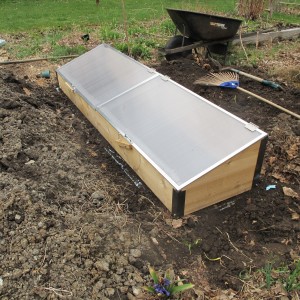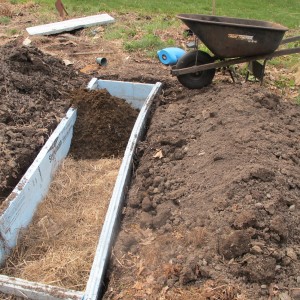Building a Hot Box for Early Spring Greens
Is your lettuce lagging? Your spring greens tired of cold, gray days? You can make a self-heating “hot box” in your garden using a cold frame, some fresh horse manure and some hard work. Lots of hard work, actually. But your lettuce and spinach will reward you sooner rather than later.
A month ago I got a cold frame from Gardener’s Supply Company (www.gardeners.com) in Burlington, Vermont. It is a nifty 8-foot by 2-foot cedar box with a slanting sides and a clear polycarbonate top that is designed to capture the sun’s heat and warm the soil inside. It assembles in an hour with just a screwdriver or screw gun. I placed it in my garden facing southwest for maximum solar gain.
Inside the cold frame I put a radio-frequency thermometer that sends the temperature to me inside my house. I found that on sunny days, with the top panels closed, that the temperature easily hit 100 degrees, or even more. It has a prop stick for each of the two opening doors on top, allowing one to vent the heat on warm days. Or you can open the top completely for hot days. It did a great job of warming the top inch or two of soil.
Lettuce and spinach can take some frost, so it didn’t matter much that at night the cold frame only kept the air temperature 3 or 4 degrees warmer than the outside air, which occasionally dropped into the mid-twenties. But I wanted an even warmer environment for my small greens.
Back during WWII when folks really grew much of their own food, people made not only cold frames, but also “hot boxes”. And I had tried it, too, some 20 years ago. The principle is easy: bury fermenting horse manure beneath a cold frame, and the heat will rise, warming the soil and air above it. I forgot just how much work that entailed.
The first challenge was to find horse manure that was not mostly bedding. Harrumph! Horses tend to be pampered these days. But I found a horse breeder who had some good fresh manure that was not full of hay or shavings. He loaded a scoop into the back of my aging pick-up truck, though that was more than I really needed. Four or five wheelbarrows is plenty.
Next I dug pit a foot deep and the size of the cold frame. That took an hour or so of hard work. I set the good top soil to one side, the subsoil to the other. Then I lined the pit with 2-inch thick Styrofoam (blueboard) insulation. Why? To keep the cold soil from cooling down my fermenting manure. I wanted the manure to stay hot so it would keep fermenting. The temperature of the manure I unloaded from my truck was in the mid-fifties, but the next day, when I was ready for my project, it had heated up to the mid-eighties. Yes!
For compost to heat up, I knew, one needs both nitrogen and carbon-based materials. Manure has plenty of nitrogen, hay and leaves are rich in carbon. So in the bottom of the pit I tossed in a layer of old hay, then I added 4-inches of manure, then a layer of hay and leaves, then another 4 inches of manure. Finally, using the good top soil I’d set aside when digging the pit, I filled up the pit.
Did it work? You bet! When the air outside is 40 degrees inside my “hot box” it is 55 degrees. At night my box keeps the air 10 to 15 degrees warmer than outside air.
Into this deluxe new domain for plants I planted 5 red cabbage starts, a dozen lettuce plants, 3 clumps of watercress, a few Swiss chard plants and 3 cilantro. All of those I’d started indoors a month earlier. I have room for some spinach that I will start by seed.
Bottom heat is good for quick germination and growth, so I imagine fresh salads tomorrow! Oh, okay, not that fast, but certainly much sooner than I would have them if I was depending on Mother Nature to warm the soil and air.
The only worry I have is that some morning I will leave the house for the day and forget to prop open the lids of the frame. If the sun comes out it could get lethally hot. But as a dedicated gardening guy, I guess I just need to put a reminder with my car keys! That should prevent any “heat emergencies”.
On another note, tulips are coming into blossom for me. I protect mine from the deer with a makeshift fence and some garlic spikes. The garlic spikes are small plastic cylinders with a clip to attach to a twig or fence and food-grade garlic oil inside. A barrier requires you to activate them by puncturing the seal with a little tool they provide. Once opened, they are stinky! Available at garden centers or on-line (www.plantprotec.com). They claim to provide protection for 6 months or more, though a fence is your best protection if there are a lot of hungry deer around.
Read Henry’s twice-weekly blog posts at www.dailyUV/henryhomeyer. Read his article there about preventing Lyme disease (https://dailyuv.com/news/





